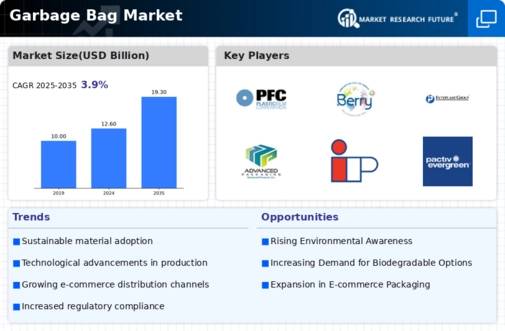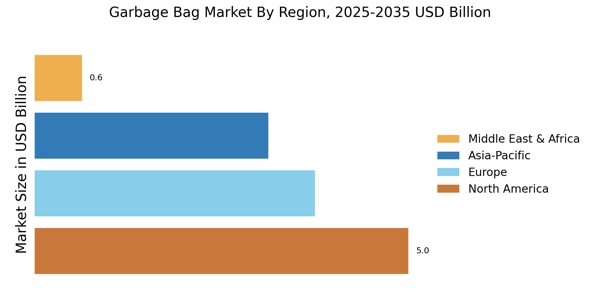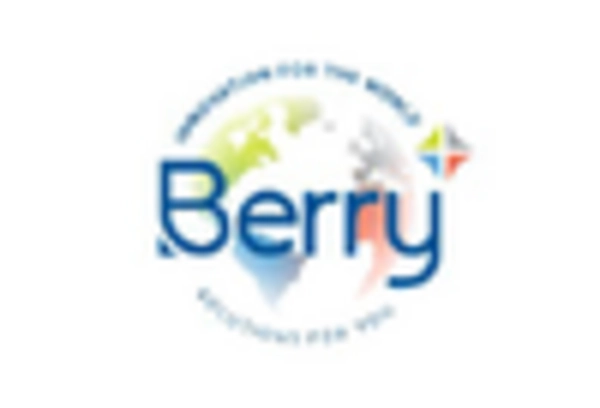E-commerce Growth
The rapid growth of e-commerce is reshaping the Garbage Bag Market in notable ways. With the rise of online shopping, there is an increasing need for packaging solutions, including garbage bags, to manage the waste generated from packaging materials. Market data suggests that e-commerce sales have surged, with projections indicating a continued upward trend. This growth creates opportunities for manufacturers to develop specialized garbage bags that cater to the unique waste profiles associated with online retail. Additionally, the convenience of online purchasing allows consumers to access a wider variety of garbage bags, including eco-friendly options. As e-commerce continues to expand, the Garbage Bag Market is likely to experience a corresponding increase in demand, driven by the need for effective waste disposal solutions.
Regulatory Compliance
Regulatory compliance is becoming increasingly critical for the Garbage Bag Market. Governments worldwide are implementing stricter regulations regarding waste management and plastic usage, prompting manufacturers to adapt their product offerings. For instance, many regions are banning single-use plastics, which directly impacts the types of garbage bags that can be produced and sold. This regulatory landscape encourages innovation, as companies seek to develop compliant products that meet both consumer needs and legal requirements. The market is witnessing a shift towards biodegradable and recyclable materials, which are more aligned with current regulations. As compliance becomes a driving force, the Garbage Bag Market is likely to evolve, with a focus on sustainable practices and materials.
Technological Innovations
Technological innovations are playing a crucial role in shaping the Garbage Bag Market. Advances in materials science have led to the development of stronger, more durable garbage bags that can withstand various waste types. Innovations such as the incorporation of recycled materials into production processes are gaining traction, aligning with sustainability goals. Furthermore, smart waste management technologies are emerging, which may include features like sensors to monitor waste levels in bins. These advancements not only enhance the functionality of garbage bags but also improve overall waste management efficiency. As technology continues to evolve, the Garbage Bag Market is expected to benefit from enhanced product offerings and improved operational efficiencies.
Rising Environmental Awareness
The increasing awareness regarding environmental issues is a pivotal driver for the Garbage Bag Market. Consumers are becoming more conscious of their ecological footprint, leading to a surge in demand for biodegradable and compostable garbage bags. This shift is reflected in market data, which indicates that the biodegradable segment is projected to grow at a compound annual growth rate of over 10% in the coming years. As individuals and organizations strive to adopt sustainable practices, manufacturers are compelled to innovate and offer eco-friendly alternatives. This trend not only caters to consumer preferences but also aligns with regulatory pressures aimed at reducing plastic waste. Consequently, the Garbage Bag Market is witnessing a transformation, with a notable increase in the production and consumption of environmentally friendly products.
Urbanization and Population Growth
Urbanization and population growth are significant factors influencing the Garbage Bag Market. As urban areas expand, the volume of waste generated increases, necessitating efficient waste management solutions. Current estimates suggest that urban populations are expected to rise by approximately 2.5 billion by 2050, leading to a corresponding increase in garbage bag consumption. This demographic shift drives demand for various types of garbage bags, including those designed for heavy-duty use in commercial settings. Furthermore, municipalities are investing in waste management infrastructure, which includes the provision of garbage bags to residents. This trend indicates a robust growth trajectory for the Garbage Bag Market, as manufacturers adapt to meet the evolving needs of urban waste management.


















Leave a Comment